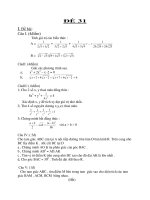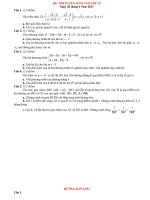77 66695 EA222 2013 1 2 1 chapter 2
Bạn đang xem bản rút gọn của tài liệu. Xem và tải ngay bản đầy đủ của tài liệu tại đây (228.04 KB, 30 trang )
2
Reviewing the literature
Learning Objectives
After studying this chapter, you should be able to understand:
What is meant by literature review?
Functions of literature review
Steps of literature review
1-2
Literature Review
is the documentation of a comprehensive review of
the published and unpublished work from secondary
sources of data in the areas of specific interest to the
researcher.
literature review
The literature review is an integral part of the
entire research process and makes a valuable
contribution to almost every operational step.
1-3
A literature review has a number of
functions
Bring clarity and focus to your research problem
Improve your methodology
Broaden your knowledge base in your research
area
Contextualise your findings
1-10
Bring clarity and focus to your
research problem
N.B. you cannot effectively start the literature review
search without an idea of the problem you wish to
investigate.
The literature review can play an extremely important
role in shaping your research problem
It also helps you to define the relationship between
your research problem and the body of knowledge in
the area.
1-14
Improve your methodology
Literature review
acquaints you with the methodologies that have been
used by others to find answers to questions similar to
the one you are investigating.
Tells you if others have used procedures and methods
similar to the ones that you are proposing, which
procedures and methods worked well for them and
what pitfalls they have faced with them.
Broaden your knowledge base in
your research area
Literature review ensures you read widely around the
subject area in which you are intend to conduct your
research study.
It is important to know what other researchers have
found in regard to the same or similar questions, what
theories have been put forward and what gap exit in
the relevant body of knowledge
Contextualise your findings
Literature review helps identifying how your findings
compare with the existing body of knowledge.
How do answers to your questions compare with
what other have found? What contribution have you
been able to make to the existing body of knowledge?
How your finding different from others?
Procedures for reviewing the
literature
There are five steps involved in conducting a
literature review:
search for existing literature in your area of study;
review the literature selected;
develop a theoretical framework;
develop a conceptual framework;
writing up the literature reviewed
1) Search for existing literature
Start with at least some idea of the broad subject area
and of the problem you wish to investigate, in order to
set parameters for your search.
Next compile a bibliography for this broad area. There
are two sources that you can use to prepare a
bibliography:
books;
journals.
Notice
Be aware that sometimes a title does not provide
enough information to decide if a book/ journal
is going to be of use.
Start with the latest issue, examine its contents
page to see if there is an article of relevance to
your research topic.
Start by reading the abstract. If it is relevant then
download and read.
2) Review the literature selected
Now that you have identified several books and
articles as useful, the next step is to start reading
them critically to pull together themes and issues
that are associated.
If you do not have a theoretical framework or
themes in mind to start with, use separate sheets of
paper for each article or book.
Once you develop rough frameworks, slot the findings
from the material so far reviewed into that framework,
using a separate sheet of paper for each themes of
that framework. As you read further, go on slotting
the information where it logically belongs under the
themes so far developed.
Notice where there are significant differences of
opinion among researchers and give your opinion
about the validity of these differences.
Ascertain the areas in which little or nothing is
known-the gaps that exist in the body of knowledge.
3) Develop a theoretical framework
As you start reading the literature, you will soon
discover that the problem you wish to investigate has
its roots in a number of theories that have been
developed from different perspectives.
4) Develop a conceptual framework
The conceptual framework stems from the theoretical
framework and concentrates, usually, on one section
of that theoretical framework which becomes the
basis of your study.
Examples of conceptual
framework
Conceptual Model
Complaint
Handling
Strategies
Satisfaction
with Service
Recovery
19
Complaint handling strategies
compensation
Problem solving
facilitation
Response speed
apology
Satisfaction
with
complaint
handling
Being courteous
explanation
effort
20
Examples of conceptual
framework
Customer
satisfaction
Customer
Loyalty
Service
Quality
21
5) Writing up the literature reviewed
While reading the literature for theoretical
background of your study, you will realize that certain
themes have emerged.
List the main ones, converting them into subheadings.
These subheadings should be precise, descriptive of
the theme in question, and follow a logical
progression.
Now, under each subheading, record the main
findings with respect to the theme in question,
highlighting the reasons for and against an argument
if they exist, and identifying gaps and issues.
Examples of Literature
Surveys
Organizational effectiveness
Organization theorists have defined
organizational effectiveness (OE) in
various ways. OE has been described in
terms of goals (Etzioni, 1960), efficiency
(Katz and Kahn, 1966), resources
acquisition (Yuchtman and Seashore,
1967). As Coutler (2002) remarked,
there is little consensus on how to
conceptualize, measure, or explain OE.
24
Examples of Literature
Surveys
Researchers are now moving away
from a single model and are taking
contingency approaches to
conceptualizing OE (Cameron,
1996; Wernerfelt, 1998; Yetley,
2001).
25









